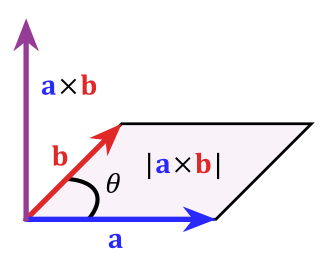Difference between revisions of "The Cross Product"
Jump to navigation
Jump to search
| Line 1: | Line 1: | ||
[[File:Cross product parallelogram.svg|thumb|Cross_product_parallelogram]] | [[File:Cross product parallelogram.svg|thumb|Cross_product_parallelogram]] | ||
| − | The cross product is an operation between two 3-dimensional vectors that returns a third vector orthogonal (i.e., perpendicular) to the first two. For vectors <math> \mathbf{u} = \langle u_1, u_2, u_3 \rangle </math> and <math> \mathbf{v} = \langle v_1, v_2, v_3 \rangle </math>, the cross product of <math> \mathbf{u} </math> and <math> \mathbf{v} </math> (notated as <math> \mathbf{u} \times \mathbf{v} </math>) is <math> \mathbf{w} = \langle u_2v_3 - u_3v_2, -(u_1v_3 - u_3v_1), u_1v_2 - u_2v_1 \rangle</math>. | + | The cross product is an operation between two 3-dimensional vectors that returns a third vector orthogonal (i.e., perpendicular) to the first two. For vectors <math> \mathbf{u} = \langle u_1, u_2, u_3 \rangle </math> and <math> \mathbf{v} = \langle v_1, v_2, v_3 \rangle </math>, the cross product of <math> \mathbf{u} </math> and <math> \mathbf{v} </math> (notated as <math> \mathbf{u} \times \mathbf{v} </math>) is <math> \mathbf{w} = \langle u_2v_3 - u_3v_2, -(u_1v_3 - u_3v_1), u_1v_2 - u_2v_1 \rangle</math>. The magnitude of the cross product, <math> |\mathbf{u} \times \mathbf{v}| </math>, equals the area of the parallelogram created by adding vector <math> \mathbf{u} </math> to vector <math> \mathbf{v} </math>, and adding <math> \mathbf{v} </math> to <math> \mathbf{u} </math> (see image). |
| + | |||
One way to remember the cross product of <math> \mathbf{u} </math> and <math> \mathbf{v} </math> is to calculate it with the following determinant: | One way to remember the cross product of <math> \mathbf{u} </math> and <math> \mathbf{v} </math> is to calculate it with the following determinant: | ||
Revision as of 17:38, 20 September 2021
The cross product is an operation between two 3-dimensional vectors that returns a third vector orthogonal (i.e., perpendicular) to the first two. For vectors and , the cross product of and (notated as ) is . The magnitude of the cross product, , equals the area of the parallelogram created by adding vector to vector , and adding to (see image).
One way to remember the cross product of and is to calculate it with the following determinant:
Resources
- The Cross Product, OpenStax
- Cross Product, Cornell University








